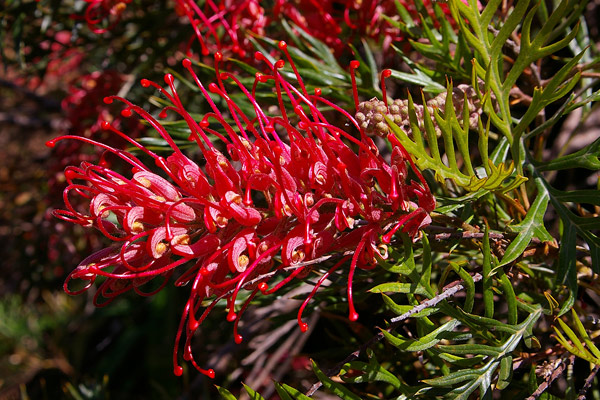
Grevilleas as Plant Allergens
Chris Jones
Allergy sufferers can tell you the different types of plants which act as triggers to their hayfever or allergies, but many plants also can cause dermatitis with very little contact.
Members of the Proteaceae family, specifically Grevillea, tend to be the main native plants implicated in contact dermatitis in Australia. This is further supported by an article by Dr. J. Menz who reported contact dermatitis from Grevillea 'Robyn Gordon' in the Medical Journal of Australia in 1985.
My own reactions occurred with Grevillea robusta, and G.olivacea, and I believed the reaction was triggered by some part of the nectar-rich blooms of G.robusta or the olive content of G. olivacea, as I am allergic to both honey and olives [Ed. The epiphet 'olivacea' refers to the similarity of the leaf colour to that of European olives and it is unlikely that the chemicals causing the contact allergy to grevillea are related to those causing a reaction to eating olives - see footnote] . However, with Dr. Menz's report and further studies subsequently carried out, such as those of Cook and Freeman who analysed cases referred to the Skin and Cancer Foundation in Sydney, it would appear that grevilleas are a common allergen responsible for allergic contact dermatitis.
Grevilleas are extensively used in landscaping of public spaces, particularly in schools, parks and gardens, as well as in private gardens. This is probably because the plants are showy, vigorous growing and they adapt well to a variety of soils and conditions. The most common plant allergen reported of the grevilleas, is that of Grevillea 'Robyn Gordon' which is a hybrid between G.bipinnatifida and a red flowering form of G. banksii.
 |
| Grevillea 'Robyn Gordon' |
The genus Grevillea contains over 300 species ranging from ,low shrubs to large trees such as the Silky Oak (Grevillea robusta) which is itself responsible for occurrences of allergic reactions as already identified. The ornamental timber of the Silky Oak is often sought after for woodwork, and it is common for people working with the timber to develop dermatitis from contact with the sawdust.
'The important allergenic species belong to the section Eugrevillea. However, it is not known whether all species contain the allergen. The allergens are pentadecylresorcinol and tridecylresorcinol. Interestingly, the resorcinol derivative in grevilleas is very similar chemically to urushiol, the sensitising agent in the genus Toxicodendron (Poison Ivy and Poison Oak) which are extremely common forms of allergic contact dermatitis in North America'.
History is rich in sources pointing to plants being responsible for contact dermatitis. As an example, 'Leichhardt, in 1847 described a member of his exploration party developing a blistering eruption after carrying grevillea pods near his skin.'
So with grevilleas perhaps the object is to admire but not touch the plants.
References
Menz, J.(1985). Contact Dermatitis from plants of the Grevillea family-two case reports. Australasian Journal of Dermatology. 26:74-6.
Menz, J., Rossi RE, Taylor, WC, & Wall,L.(1986). Contact Dermatitis from Grevillea 'Robyn Gordon'. Contact Dermatitis. 15: 126-3.
David K. Cook & Susanne Freeman (1997). Allergic Contact Dermatitis to Plants: an analysis... Australasian Journal of Dermatology 38: 129-131
Lothian, N.(1989). Grevillea species & Hybrids causing Contact Dermatitis. Australasian Journal of Dermatology 30: 111-113.
Freeman, S. (2004). Allergy to Grevilleas, Australian Plants Vol.22, No. 181 pp.355-6.
Footnote (April 2014): Thanks to Anna Monro, Manager, Botanical Information, Australian National Botanic Gardens for this clarification.
This article is from the newsletter of ANPSA's Wildlife and Native Plants Study Group, Autumn-Winter 2009.
Australian Plants online - 2009
Australian Native Plants Society (Australia)
|